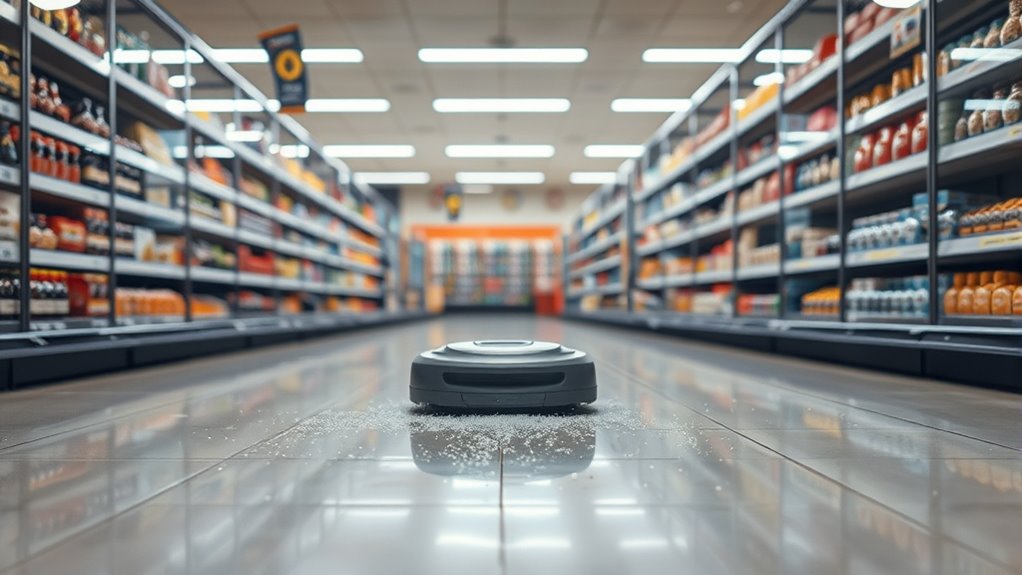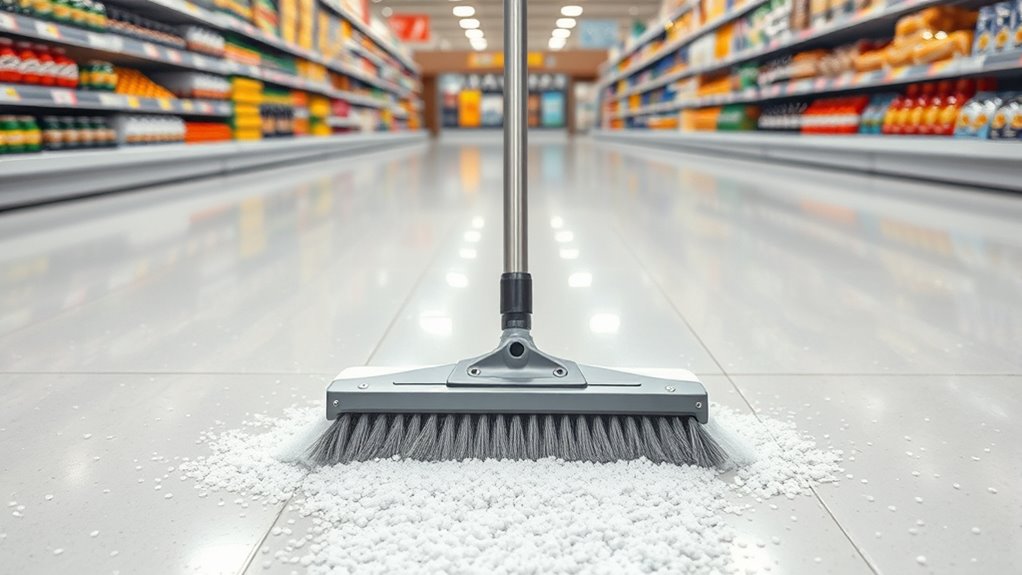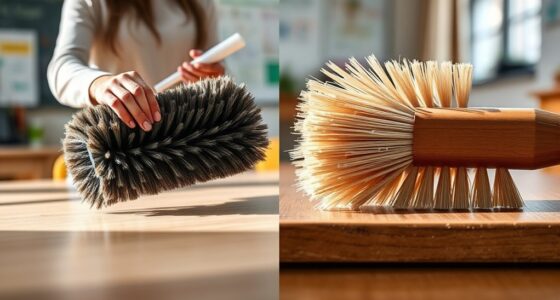To keep shop aisles free of sand and salt without scratching floors, use soft-bristled brooms or microfiber dust mops with gentle, overlapping strokes. Sweep regularly during peak winter months, especially in high-traffic areas and along edges and corners. Avoid harsh scrubbing and test cleaning solutions on a small area first. Consistent gentle sweeping combines safety and surface preservation—stay with us to discover more tips for maintaining a scratch-free environment.
Key Takeaways
- Use soft-bristled brooms or microfiber dust mops for gentle debris removal.
- Sweep with overlapping, gentle strokes to prevent scratching sensitive flooring surfaces.
- Schedule multiple cleanings during peak winter months, focusing on high-traffic areas.
- Test cleaning solutions on small areas to avoid surface damage before full use.
- Train staff to recognize debris buildup and employ proper, scratch-free sweeping techniques.

During winter months, sand and salt often spill onto shop aisles, creating hazards for customers and employees alike. These materials, vital for melting ice outside, become unwanted winter debris inside your store, making aisle maintenance more challenging. Left unchecked, they can cause slips and falls, damage flooring, and compromise safety. That’s why establishing a scratch-free sweeping routine is essential for keeping your aisles clean and safe throughout the season.
Winter debris like sand and salt can cause slips and floor damage; regular, gentle sweeping keeps aisles safe and clean.
Your first step is understanding how winter debris accumulates. As customers walk in from snowy, salted sidewalks, they track in small granules and salt crystals. Over time, this debris builds up along the aisles, especially in high-traffic areas. Regular sweeping is your best defense against buildup. But standard sweeping methods can be too harsh, risking scratches on delicate flooring or finishes. Instead, opt for soft-bristled brooms or microfiber dust mops that effectively pick up debris without damaging surfaces.
A key aspect of aisle maintenance during winter is timing. Don’t wait until debris becomes obvious or a hazard. Schedule frequent cleanings, especially during peak snow and salt periods. Morning and late-afternoon sweeps help prevent accumulation and reduce the risk of slipping. When sweeping, use gentle, overlapping strokes to lift debris without scratching the floor. Pay special attention to corners, edges, and under shelves, where winter debris tends to settle.
Using the right tools makes a significant difference. A microfiber dust mop can trap fine salt particles more effectively than traditional brooms, reducing the need for aggressive sweeping that might harm the flooring. Dry sweeping is usually sufficient for initial debris removal, but for sticky or stubborn salt residues, a damp mop or a specialized cleaning solution might be necessary. Always test cleaning products on a small area first to make sure they won’t cause damage or discoloration.
Additionally, you should train your staff to recognize signs of damage or excessive debris buildup. Promptly addressing these issues prevents long-term flooring problems and keeps the shopping environment inviting. Incorporating a routine inspection into your aisle maintenance plan ensures that debris is promptly removed before it causes safety hazards or surface deterioration. Being aware of flooring types helps select the most appropriate cleaning methods that prevent scratches and maintain the store’s appearance.
Maintaining a scratch-free environment during winter requires consistent effort and attention to detail. By implementing a careful, regular sweeping routine focused on removing winter debris, you protect your floors and provide a safer shopping experience. Remember, the key is gentle, frequent cleaning combined with the right tools. That way, your aisles stay clear, safe, and inviting—even during the snowiest months.
Frequently Asked Questions
How Often Should Shop Aisles Be Swept During Winter?
During winter, you should sweep shop aisles daily to maintain safety and cleanliness. Incorporate seasonal maintenance into your routine, especially after storms or heavy foot traffic. Regular sweeping helps prevent slips and falls, adhering to safety protocols. By staying proactive, you reduce the buildup of sand and salt, ensuring your aisles remain safe and scratch-free, even in harsh weather conditions. Consistent cleaning is key to a safe shopping environment.
What Are the Best Tools for Removing Sand and Salt Effectively?
Removing sand and salt is like clearing a path through a winter storm. Use industrial brooms for heavy-duty debris and microfiber sweepers for delicate surfaces. Industrial brooms sweep up coarse particles efficiently, while microfiber sweepers pick up fine dust without scratching. Together, these tools guarantee a thorough, scratch-free clean. Keep the aisles safe and spotless by combining these tools regularly, especially during winter months.
Does Salt Damage Certain Types of Flooring Over Time?
Yes, salt can damage certain types of flooring over time, especially those with lower flooring durability. It can cause surface erosion, discoloration, and deterioration if not cleaned promptly. To protect your floors, choose salt-resistant materials like sealed concrete or tile, and regularly sweep and wash away salt deposits. This proactive approach helps maintain the integrity and appearance of your flooring, preventing long-term damage caused by salt exposure.
Are There Eco-Friendly Alternatives to Salt for Ice Control?
Oh, absolutely, because nothing says progress like tossing eco friendly deicers and natural ice melt onto our winter messes, right? These clever alternatives, such as calcium magnesium acetate and potassium chloride, do a splendid job without the environmental guilt. You get safer surfaces, fewer damages, and the joy of knowing you’re helping Mother Earth stay a little happier. Who knew winter could be so virtuous and snowy at the same time?
How Can Shops Prevent Sand and Salt From Tracking Into Storage Areas?
To prevent sand and salt from tracking into storage areas, you should place entrance mats at all access points. Guarantee these mats are large and absorbent enough to trap debris. Additionally, encourage employees to wear designated footwear that minimizes dirt transfer. Regularly clean and replace mats to maintain their effectiveness. Implementing these steps keeps your storage areas cleaner and reduces scratch risks, maintaining a professional appearance and safety.
Conclusion
By adopting this scratch-free sweeping routine, you’ll keep your shop aisles pristine and inviting—like a gust of fresh air in a busy world. Think of your cleaning as a dance, each move purposeful and graceful, ensuring dirt and debris never have a chance to settle. With consistent care, your aisles will shine brighter than ever, inviting customers in and making your store a shining example of cleanliness. After all, a spotless shop speaks volumes about your attention to detail.









